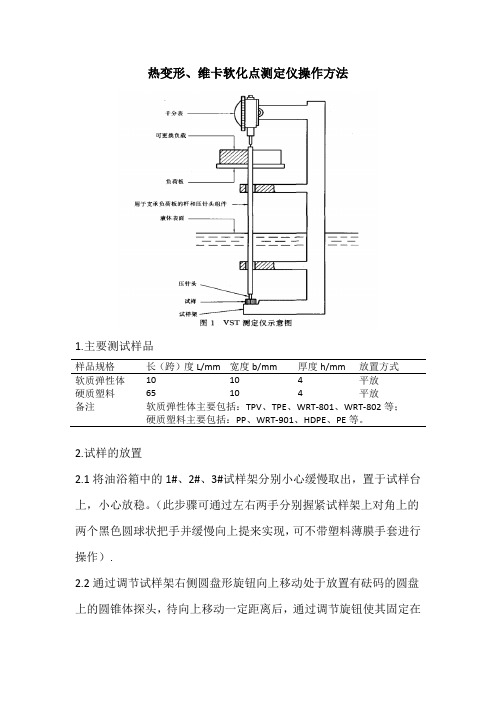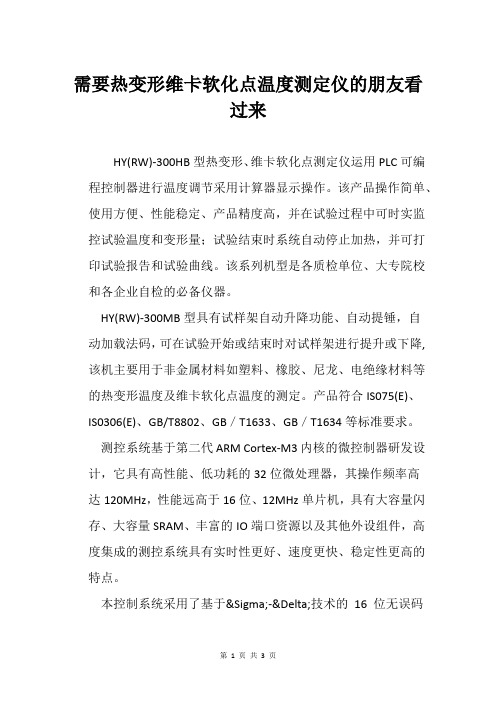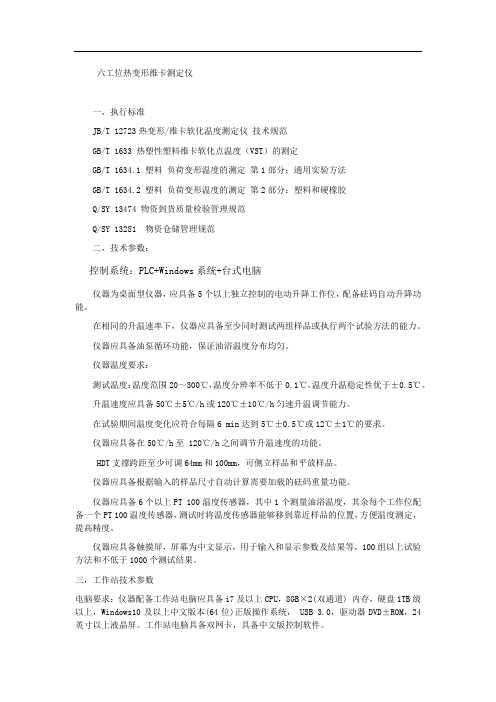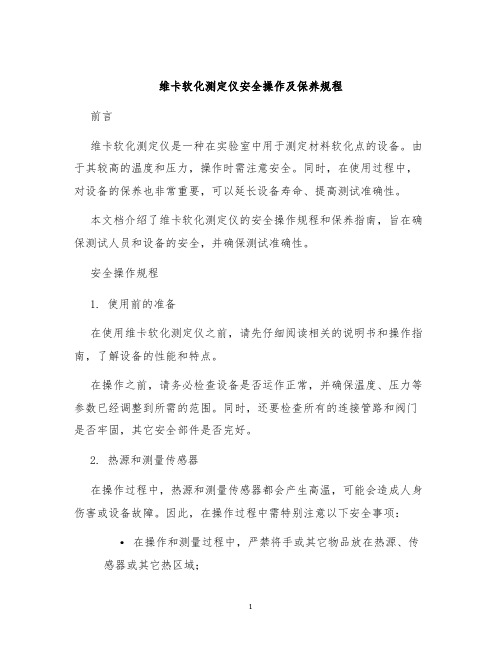意大利CEAST公司热变形维卡软化点仪
热变形维卡点测定仪安全操作及保养规程

热变形维卡点测定仪安全操作及保养规程1. 前言热变形维卡点测定仪是一种常用于材料热变形性能测试的仪器设备。
为了确保使用过程中的安全性和设备的长期可靠运行,本文将介绍热变形维卡点测定仪的安全操作规程和保养规程。
2. 安全操作规程在使用热变形维卡点测定仪时,请务必遵循以下操作规程:2.1. 安全环境•在使用热变形维卡点测定仪之前,确保实验室或测试场地符合相关的安全要求和标准。
•确保仪器与其他设备之间有足够的距离,以确保空气流通。
•在使用过程中,确保周围环境干燥,并避免灰尘积聚。
2.2. 熔融样品处理•在处理熔融样品时,必须佩戴适当的个人防护设备,如乳胶手套和护目镜。
•使用预先制备好的熔融样品,并按照仪器操作手册中的要求进行操作。
•避免直接接触热变形维卡点测定仪的加热和冷却装置。
2.3. 电源和电气设备•当使用热变形维卡点测定仪时,应确保设备的电源和电气设备处于良好工作状态,并符合相关的安全要求。
•不要将电源线与任何尖锐物体或电源设备放在一起,以避免电源线损坏或发生触电事故。
•在操作过程中,避免水或其他液体进入仪器的电气部件,以防止短路和损坏。
2.4. 设备操作•仔细阅读并理解热变形维卡点测定仪的操作手册,并按照要求进行操作。
•在启动、关闭或进行设备维护时,确保设备已完全停止运行,并拔下电源插头。
•避免使用损坏或磨损的操作按钮,以免导致设备故障或人身伤害。
2.5. 紧急情况处理•若发生设备故障、漏电、短路或其他紧急情况时,立即停止使用并拔下电源插头。
•在紧急情况结束后,必须经过专业人员的检查和修理,才能继续使用热变形维卡点测定仪。
3. 保养规程为了确保热变形维卡点测定仪的长期可靠运行和延长设备寿命,应按照以下保养规程进行定期保养:3.1. 清洁维护•每次使用后,应使用干净的抹布或纸巾擦拭热变形维卡点测定仪的外壳和相关配件,保持其干净整洁。
•定期清洁设备内部的灰尘和污垢,以确保仪器正常运行。
3.2. 润滑保养•定期对热变形维卡点测定仪的滚轮、导轨和其他运动部件进行润滑保养,以减少摩擦和磨损。
热变形及维卡软化点温度测试仪温度参数在线校准方法

热变形及维卡软化点温度测试仪温度参数在线校准方法符堃 / 上海市计量测试技术研究院摘 要 针对热变形及维卡软化点温度测试仪的在线校准,使用数据采集器对动态温度数据进行采集和分析。
本文推荐了两种不同的温度参数在线校准方法。
利用测量数据进行比对,并评定了测量不确定度。
分析并结合两种方法的优劣得到最佳的温度参数校准结果。
关键词 热变形;维卡软化点;温度;在线校准;不确定度0 引言热变形及维卡软化点温度测试仪(以下简称测试仪)用来测试塑料成型后的热变形温度和维卡软化点温度两项重要的热性能指标,为控制产品的质量或作为产品使用条件提供参考[1]。
测试仪一般由油浴槽、温度控制系统、一个或多个试样支架、搅拌装置、负载装置、测试软件等组成,可以实时监控实验温度及实验形变量曲线。
测试仪的校准参数主要有铂电阻温度、升温速率(时间)、负载砝码及形变量测量系统。
测试仪作为一种多参数的大型实验设备,需要进行周期性校准以保证其准确度。
基于它的校准方法论述比较缺乏,并由于温度参数直接作为测试结论,本文主要介绍温度参数的在线校准方法,并进行不确定度评定。
其他参数的校准相对于温度参数校准较为简单,本文不做阐述。
1 温度校准方法一1.1 原理热变形温度(heat deflection temperature,HDT)是指,对浸在一定升温速率(50 ℃/h或120 ℃/h)导热介质中的一定尺寸矩形试样施以规定负载、试样中心的变形量达到与试样尺寸所对应的形变量时的温度。
维卡软化点温度(vicat softening temperature, VST)是将热塑性塑料放置于液体传热介质中,在一定的负荷(1 000 g或5 000 g)和升温速率(50 ℃/h 或120 ℃/h)条件下、试样被直径1 mm2的针头压入1 mm时的温度。
1.2 校准方法测试仪共有六个工作站,每个工作站都有一根测量铂电阻,整个油浴槽中有一根控温铂电阻。
在实验前,将规定试样放置在每个工作站上,然后加上负载,并连接位移测量系统。
新型聚烯烃弹性体OBC增韧共聚PP的研究

第23卷第5期高校化学工程学报No.5 V ol.23 2009 年10月 Journal of Chemical Engineering of Chinese Universities Oct. 2009文章编号:1003-9015(2009)05-0813-06新型聚烯烃弹性体OBC增韧共聚PP的研究李晨, 范宏, 鲁列, 郭春文, 李伯耿(浙江大学化学工程与生物工程学系化学工程国家重点实验室, 浙江杭州 310027)摘要:进行乙烯-辛烯嵌段型共聚物(OBC)共混改性共聚级聚丙烯(Co-PP)的研究,考察了共混物的冲击强度、拉伸强度、断裂伸长率、熔体流动指数、维卡软化点等机械物理性能和冲击断面形貌,进行了动态力学分析,并与Co-PP/乙烯-辛烯无规共聚物(POE)、Co-PP/乙烯-丁烯共聚物(EBC)共混体系比较。
结果表明,弹性体含量达到10%(wt)时,三种共混体系均已基本实现“脆韧转变”,含较长支链的OBC与POE对Co-PP有更好的增韧效果;低温下,Co-PP/OBC的抗冲性能尤佳,其低温内耗峰温度低、储能模量高。
OBC大分子链中PE嵌段的存在,使其自身及其与Co-PP共混物的加工与耐热性均明显优于其它两种弹性体。
关键词:共聚级聚丙烯;聚烯烃弹性体;增韧改性;乙烯-辛烯嵌段型共聚物中图分类号:TQ325.14 文献标识码:AResearch on Toughening Modification of Copolymerized Polypropylene UsingPolyolefin ElastomersLI Chen, FAN Hong, LU Lie, GUO Chun-wen, LI Bo-geng (State Key Laboratory of Chemical Engineering, Department of Chemical and Biochemical Engineering,Zhejiang University, Hangzhou 310027, China)Abstract: Compared with the polyolefin elastomers of ethylene-octene random copolymer (POE) and ethylene-butene random copolymer (EBC), a new polyolefin elastomer, ethylene-octene block copolymer (OBC), was used to blend with copolymerized polypropylene (Co-PP) and to form the toughening modified Co-PP alloy. The mechanical and physical properties of the toughening modified alloys, such as impact strength, tensile strength, elongation at break, melt flow index, Vicat softening point and morphologies of the impact fracture surface, were investigated. The dynamic mechanics of the alloys were analyzed too. The results show that all the three kinds of Co-PP alloys (Co-PP/OBC, Co-PP/POE and Co-PP/EBC) have almost accomplished the “brittle-ductile transition” when their elastomer content is higher than 10%(wt), and both the ethylene-octene copolymers (OBC and POE) with longer branched chains have better toughening effect on Co-PP. Especially at low temperatures, the Co-PP/OBC alloy has higher impact strength, storage modulus and lower loss peak temperature. Since there is polyethylene blocks existing in the chains of OBC, both OBC and its alloy with Co-PP have better processability and higher thermal deformation temperature.Key words: Co-polypropylene; polyolefin elastomer; toughening modification;ethylene-octene block copolymer1前言聚丙烯(PP)原料来源丰富,合成工艺相对简单,且具有密度小、刚性、耐热性、电绝缘性好等优点,已成为通用树脂中发展最快的品种之一。
热变形维卡软化点试验机常见故障原因及排除方法

热变形维卡软化点试验机常见故障原因及排除方法标题:深度剖析热变形维卡软化点试验机常见故障原因及排除方法导言:热变形维卡软化点试验机作为一种常用的材料测试设备,其稳定、精准的运行对于材料研究和品质控制至关重要。
然而,在长时间的使用过程中,试验机也可能会出现各种故障,影响测试结果的准确性和可靠性。
本文将对热变形维卡软化点试验机常见故障原因及排除方法进行深入探讨,为使用者提供解决问题的参考。
一、机械部分故障1. 试验机工作台无法升降热变形维卡软化点试验机在使用过程中,可能会出现工作台无法升降的情况。
这一故障的可能原因有:液压系统故障、搅拌器卡死、电机故障等。
解决方法包括检查液压油管路、清洁搅拌器、检查电机接线等。
2. 加热系统异常试验机的加热系统异常可能会导致试验温度不稳定或无法达到预设温度。
故障原因可能是电热管损坏、控制系统故障、温度传感器失灵等。
解决方法包括更换损坏的电热管、检修控制系统、更换温度传感器等。
二、控制系统故障1. 控制程序错误热变形维卡软化点试验机的控制系统可能会出现程序错误的情况,导致试验无法进行或者数据不准确。
此时需要检查控制程序,修正其中的错误,并进行重新校准。
2. 仪器读数不准确如果试验机的读数不准确,可能是控制系统的参数设置错误或者传感器故障引起的。
解决方法包括重新设置参数、更换故障传感器等。
总结:热变形维卡软化点试验机的故障原因多种多样,可能涉及机械部分、控制系统等多个方面。
及时发现并排除故障对于保证试验结果的准确性和仪器的长期稳定运行至关重要。
只有充分了解试验机的结构和工作原理,才能更好地排除故障,确保试验工作的顺利进行。
个人观点:作为热变形维卡软化点试验机的使用者,应该对其常见故障原因及排除方法有所了解,以便在出现故障时能够及时处理。
也需要定期对试验机进行维护和保养,预防故障的发生,确保试验数据的准确性和可靠性。
以上是对热变形维卡软化点试验机常见故障原因及排除方法的深入分析,希望对您有所帮助。
热变形、维卡软化点温度测定仪技术参数

热变形、维卡软化点温度测定仪技术参数概述热变形、维卡软化点温度测定仪用于测定各种塑料、橡胶等热塑性材料的热变形温度和维卡软化点温度。
广泛应用于塑胶原料和制品的生产、科研和教学中。
该系列仪器结构紧凑、造型美观、质量稳定、并具有排出油烟异味污染和冷却功能。
采用先进的MCU(多点微控制单元)控制系统,自动测控温度和变形、自动计算试验结果,可循环存储10组试验数据。
该系列仪器有多种机型供选择:自动型采用液晶屏中(英)文显示,自动测量;微控型可连接电脑、打印机,由计算机进行控制,试验软件WINDOWS中(英)文界面,具有自动测量、实时曲线、存储数据、打印输出等功能。
执行标准仪器符合ISO75、ISO306、GB/T1633、GB/T1634、GB/T8802、ASTM D1525、ASTM D648标准要求。
技术参数及指标1、温控范围:室温~300℃2、升温速率:120℃/h [(12±1)℃/6min] 50℃/h [(5±0.5)℃/6min]3、最大温度误差:±0.5℃4、形变测量范围:0~3mm5、最大形变测量误差:±0.005mm6、形变测量显示精度:±0.01mm7、试样架(测试工位): 48、试样支撑跨距:64mm、100mm9、负载杆和压头(刺针)重量:71g10、加热介质要求:甲基硅油或标准中规定的其它介质(闪点大于300℃)11、冷却方式:150℃以下水冷,150℃以自然冷却或风冷(风冷设备需自备)12、具有上限温度设定,自动报警。
13、显示方式:液晶中(英)文显示14、可显示测试温度,可设定上限温度,自动记录试验温度,温度达到上限值后自动停止加热。
15、变形测量方法:专用高精度数显表+自动报警。
16、具有自动排除油烟系统,可有效抑制油烟散发,时刻保持室内良好空气环境。
17、电源电压:220V±10% 10A 50Hz18、加热功率:3kW。
意大利CEAST公司熔融指数仪

The CEASTModular Melt Flow,ADVANCED FIRMWARE •User friendly man-machine interface with menus and scroll lists •Possibility to store up to 25 sets of test parameters •Parameters are pre-selected for ASTM D 1238 and ISO 1133 in default and can be modified and saved •Up to 40 data points can be acquired over 30 mm of piston travel during test with the possibility to discard or restore the values outof tolerance (if necessary) for the last test performed•Test parameters can be selected: starting point defined by pistonposition or elapsed time, measurement duration and steps number,etc.•Customized test settings: automatic print of results, automaticweight lifting at test end, etc.•Assisted Test Mode: acoustic alarms prompt the operator for massapplication, extrudate cutting and end of test•Melt Density calculation based on actual weight of the extrudate,measured at the end of the last test performed•Password access control for: operator, supervisor, and maintenance•Special firmware developments are available on request.DATA OUTPUT Displayed during test:•MFI or MVR at each step •Average MFI or MVR •Time of each step •Total time •Real and Set temperatures•Piston position•Real Time and Position of test initiation•A USB Port can connect the instrument directly to a printer.SEMI-AUTOMATIC TEST CYCLES•7025.000, 7026.000, 7027.000 capable of performingsemi-automatic test cycles•Operator enters test parameters and inserts the material•Piston loading and test execution follow automatically•7027.000 can also perform pre-heating and compactingautomatically.PC INTERFACE •VisualMELT software can control test and instrument, see the last page of this brochure for details.•Up to eight (8) Modular Melt Flow instruments can beindependently controlled with a single PC.•The RS232 Serial Port can be used to connect the instrument toa PC. Shortly, this will also be possible using the USB port.CERTIFICATES•Certification of each individual nozzle, piston and barrel usingcertified equipment is supplied with the instrument•Optional certificates are available for the test masses andreference thermometers.BASIC FEATURESDesigned with compact and strong construction.•Instant results on the on-board display•Direct print-out of test report•On board keyboard for: data input, test execution, temperaturecontrol, timing, lifting, cutting, data acquisition, calculation, andfinal reporting.STANDARDS •ISO 1133 A-B, ASTM D 1238. Procedures A, B and C(Plus Multiple-Weight Procedure D with MFM 7027.000)and other equivalents.MODULARITY •Upgrade from the most basic model (code 7023.000) to the most complete model (code 7026.000) in your labs •Top model, 7027.000, has common accessories and options.OVEN•Unique heat sink around the barrel to ensure maximumtemperature stability•Special thick Durasil® insulation plates ensure minimum heat loss•Minimum temperature variation when polymer is inserted into the barrel.Vanguard ElectronicsUSER-FRIENDLY CALIBRATION•All calibration parameters can be edited using either the keyboard,or downloaded using the serial port and PC connection •Upgradeable Firmware: Flash Memory allows upgrading of firmware via PC connection.MODULAR MELT FLOW SERIES: ENHANCED MODELSFor performing tests according to ASTM D 1238 and ISO 1133 Procedures A, B and C (Melt Mass-Flow Rate “MFR” and Melt Volume-Flow Rate “MVR”) gravitational and volumetric methods: the instrument measures the travel of the piston in theThe First Step:Melt Mass-Flow Rate (Mass Method, Basic Melt Index) According to ASTM D 1238, ISO 1133 Procedure A and other equivalents Evolution and Enhancements:Melt Volume Rate (Volume Method)According to ASTM D 1238, ISO 1133 Procedure A, B and C and other equivalents7023.0007025.0007026.000MODULAR MELT FLOW code 7027.000An evolution in Melt Flow Testing:A single test can be performed with one, two or three test weights in increasing OR decreasing weight order. Initial rheological data can be gained from these tests, including the shear sensitivity and the initial points of the MODULAR MELT FLOW LINE COMMON TECHNICAL DATA Piston Position Reading - Accuracy: ±0.02 mm (using encoder).Masses - Tolerance: ±0.5%Range of loads: from to 0.325 kg (3.19 N) to 21.600 kg (211.9 N). Barrel (extrusion cylinder) - Nitride hardened steelTemperature - Time to reach stable test temperature: approx. 10 minutesTemperature range: 50 ÷400°C (on request 450°C)Temperature display resolution: 0.1°CThermal stability: ±0.2°C from 50 to 400°CA thermal fuse protects the instrument from potential fire hazard. Nozzle - Standard nozzle (ISO 1133/ASTM D 1238): tungsten carbideSpecial nozzles are available with different geometries(for example ASTM D 3364 and ISO 292(b)).All nozzles are supplied with individual serial numbers and conformancecertificates.Language - On-board program language can be selected from:English, French, German, Italian, and Spanish.OPTIONAL ADVANCED EQUIPMENT FEATURES FOR ALL MODELS (See the table on the next page for further details).Die Swell - code 7023.040/7027.040System complete with: laser detection system, for measuring extrudate diameter and software calculation of the die swell ratio.Nozzle Plug - code 7023.006Die Plug for polymers with low molecular weight and quick flow to keep the polymer in the barrel during pre-heating (for Procedure C).Automatic Cleaning Device – code 7023.030/7027.030Cleaning device, mounted on the weight lifter, that swings into place. At the touch of a button, the pneumatically driven up-and-down movement effectively removes all traces of even the most difficult polymer from the barrel. Nitrogen Blanket – code 7027.070Useful for testing hygroscopic polymers (such as PET, polyamides and Nylon®), this accessory puts the polymer being tested under a Nitrogen gas blanket, keeping the polymer dry during the test.Special Kits for Aggressive MaterialsTo be used when corrosive materials must be tested. Piston, barrel and nozzle are supplied in special material, resistant to corrosion from the acids evolvedcode - 6934.035code - 6934.036. Other options are available upon request.7027.000See two complete test examples on following pagetspwH tH rT rH pH cTest endSpecialists in rheology and data processing… not all Melt Flow Testers are alikeDisplay of dataand elaboration9Weight SetFor 2.16 – 5.0 - 21.6 kg Support for 1 mass Support for 2 massesVisualMELT SOFTWARE code 0710.650The main programme controls all functions of the Modular Melt Flow.From a library of international standards you may select any test parameters, or enter your own. Graphs and tables can be easily stored and recalled. It is also possible, manually or automatically, to discard and restore values that are not in tolerance as required. Test results include: MFR and MVR, values and graphic of single steps,test time, statistical data, velocity and variance, thermal stability,shear rate, shear stress and viscosity. For tests performed with our model 7027.000 it is also possible to calculate the shear sensitivity and graph the initial part of the rheological curve.Full details can be found in our VisualMELT Brochure.ModelPart DescriptionVisualMELT SoftwareMultiModules for Connecting two,four oreight MMFVisualMELTSoftware Modules:Operator (Password levels)SQC (Statistics Package)Transfer (to Excel® or ASCII)Weight (correct Melt Density)MODULAR MELT FLOW 0710.6500710.653.20710.653.40710.653.80710.6510710.6570710.6520710.6587027.0007026.0007025.0007024.0007023.000Code -Not Available Optional IncludedExpanded Data Analysis With advanced processing of the experimental data further rheological and processing information may be obtained:•Melt Density •Estimate of filler content •Flow Rate Ratio •Thermal Stability These instruments are made in compliance with CE health and safety requirements CEAST GmbHCEAST Asia Pte. Ltd. CEAST USA INC.CEAST S.p.A.40 Points test data reportCEAST’s VisualMELT,------A P 7023-05 0407- P u b b l i c i t ào l t r e i d e a - T O R I N O - P r i n t e d i n I t a l y。
热变形、维卡软化点测定仪操作方法

热变形、维卡软化点测定仪操作方法1.主要测试样品样品规格长(跨)度L/mm 宽度b/mm 厚度h/mm 放置方式软质弹性体10 10 4 平放硬质塑料65 10 4 平放备注软质弹性体主要包括:TPV、TPE、WRT-801、WRT-802等;硬质塑料主要包括:PP、WRT-901、HDPE、PE等。
2.试样的放置2.1将油浴箱中的1#、2#、3#试样架分别小心缓慢取出,置于试样台上,小心放稳。
(此步骤可通过左右两手分别握紧试样架上对角上的两个黑色圆球状把手并缓慢向上提来实现,可不带塑料薄膜手套进行操作).2.2通过调节试样架右侧圆盘形旋钮向上移动处于放置有砝码的圆盘上的圆锥体探头,待向上移动一定距离后,通过调节旋钮使其固定在此高度,然后左手捏住试样杆末端的压头(因为此压头与试样杆间为套入式连接,一旦单独抽离试样杆,压头会与试样杆分离,若不用手捏住,会掉入油浴箱中,难以重新取出!)向上顶起试样杆,从而使处于试样架底部的试样(通常为上一次实验完成后还未取出的试样)与压头脱离,并用右手迅速取出试样,然后换上本次所需测试试样,并按要求放置,之后用压头压紧,再次通过调节试样架右侧圆盘形旋钮向下移动圆锥体探头,直至刚好接触到需要放置砝码的圆盘的圆心位置(通常为了便于之后的零点位置较正,锥体探头与圆盘中心可相隔1mm左右),然后通过调节旋钮使其固定在此高度,从而固定住压头与所测试样。
(此过程中,涉及到需要接触试样杆、压头及试样的操作步骤,需要带上塑料薄膜手套以防止硅油对手的污染)2.3 依次放置好1#、2#试样架中的试样(3#试样架有故障不能进行正常实验故无需放置试样),然后依次将1#、2#、3#试样架分别小心缓慢的放入油浴池中(若不放置3#试样架,在程序升温过程中,当温度过高时,硅油会挥发出油浴箱,对实验室环境造成污染)。
3.压头的选择及圆盘上所需加载砝码质量的计算样品规格所选压头或压针型号测试项目负载计算公式依据标准所需加载砝码质量实际加载砝码质量软质弹性体压针维卡软化点(1)GB/T1633-2000.A50法1000g 50g硬质塑料压头热(负荷)变形温度(2)GB/T1634.1—200425g 20g备注(1):压针施加在试样上的法向正应力g S m m m ∙++=压针砝码压针杆σ 其中: σ=10N S=1 mm 2 m 杆+m 压针=50g(2)压头施加在试样上的作用力L h b F f *∙∙*=322σ其中:σf =0.45MPa b=10mm h=4mm L=65mm F=(m 杆+m 压头+m 砝码)g4.1操作系统及参数设定首先打开热变形、维卡软化点测定仪电源开关,待指示灯与操作屏幕界面稳定后,按依据提示进入操作,分别设置好升温范围,升温速率,目标距离;在砝码盘上放置好砝码后对1#、2#试样架进行位置调节,先使其位置处于+0.5mm 之间,之后进行重新调零校正。
需要热变形维卡软化点温度测定仪的朋友看过来

需要热变形维卡软化点温度测定仪的朋友看过来HY(RW)-300HB型热变形、维卡软化点测定仪运用PLC可编程控制器进行温度调节采用计算器显示操作。
该产品操作简单、使用方便、性能稳定、产品精度高,并在试验过程中可时实监控试验温度和变形量;试验结束时系统自动停止加热,并可打印试验报告和试验曲线。
该系列机型是各质检单位、大专院校和各企业自检的必备仪器。
HY(RW)-300MB型具有试样架自动升降功能、自动提锤,自动加载法码,可在试验开始或结束时对试样架进行提升或下降,该机主要用于非金属材料如塑料、橡胶、尼龙、电绝缘材料等的热变形温度及维卡软化点温度的测定。
产品符合IS075(E)、IS0306(E)、GB/T8802、GB/T1633、GB/T1634等标准要求。
测控系统基于第二代ARM Cortex-M3内核的微控制器研发设计,它具有高性能、低功耗的32位微处理器,其操作频率高达120MHz,性能远高于16位、12MHz单片机,具有大容量闪存、大容量SRAM、丰富的IO端口资源以及其他外设组件,高度集成的测控系统具有实时性更好、速度更快、稳定性更高的特点。
本控制系统采用了基于Σ-Δ技术的16 位无误码数据的AD芯片,先进的PID控制算法使控制平稳可靠,基于带CRC校验的主从通讯模式,数据安全可靠。
本系统由三部分组成:温度采集控制模块、千分表数据采集模块及PC应用软件。
热变形维卡软化点温度测定仪主要技术参数:1.温度控制范围:环境温度—300℃2.升温速率:(120±10)℃/h(12±1)℃/6min(50±5)℃/h(5±0.5)℃/6min3.温度示值误差:0.1℃4.温度控制精度:±0.5℃5.最大形变示值误差:±0.001mm,6.变形测量范围:0—5mm7.实验架个数:3个8.负载杆及托盘质量:68g9.标准砝码:一套10.加热介质:甲基硅油(运动粘度一般选择200厘斯)或变压器油11.冷却方式:150℃以上自然冷却,150℃以下水冷或自然冷却。
热变形维卡试验仪(1)

六工位热变形维卡测定仪一,执行标准JB/T 12723热变形/维卡软化温度测定仪技术规范GB/T 1633 热塑性塑料维卡软化点温度(VST)的测定GB/T 1634.1 塑料负荷变形温度的测定第1部分:通用实验方法GB/T 1634.2 塑料负荷变形温度的测定第2部分:塑料和硬橡胶Q/SY 13474 物资到货质量检验管理规范Q/SY 13281 物资仓储管理规范二,技术参数:控制系统:PLC+Windows系统+台式电脑仪器为桌面型仪器,应具备5个以上独立控制的电动升降工作位,配备砝码自动升降功能。
在相同的升温速率下,仪器应具备至少同时测试两组样品或执行两个试验方法的能力。
仪器应具备油泵循环功能,保证油浴温度分布均匀。
仪器温度要求:测试温度:温度范围20~300℃,温度分辨率不低于0.1℃,温度升温稳定性优于±0.5℃。
升温速度应具备50℃±5℃/h或120℃±10℃/h匀速升温调节能力。
在试验期间温度变化应符合每隔6 min达到5℃±0.5℃或12℃±1℃的要求。
仪器应具备在50℃/h至 120℃/h之间调节升温速度的功能。
HDT支撑跨距至少可调64mm和100mm,可侧立样品和平放样品。
仪器应具备根据输入的样品尺寸自动计算需要加载的砝码重量功能。
仪器应具备6个以上PT 100温度传感器,其中1个测量油浴温度,其余每个工作位配备一个PT 100温度传感器,测试时将温度传感器能够移到靠近样品的位置,方便温度测定,提高精度。
仪器应具备触摸屏,屏幕为中文显示,用于输入和显示参数及结果等,100组以上试验方法和不低于1000个测试结果。
三,工作站技术参数电脑要求:仪器配备工作站电脑应具备i7及以上CPU,8GB×2(双通道) 内存,硬盘1TB级以上,Windows10及以上中文版本(64位)正版操作系统, USB 3.0,驱动器DVD±ROM,24英寸以上液晶屏。
热变形维卡软化点试验仪技术文章英语

热变形维卡软化点试验仪技术文章英语Vicat Softening Temperature Tester: A Comprehensive Technical Article.Introduction.The Vicat softening temperature test is a widely used technique for determining the softening point of thermoplastic materials. Developed by French chemist Louis Vicat in the early 19th century, this test evaluates the temperature at which a material undergoes a transition from a solid to a semi-liquid state. The Vicat softening temperature provides valuable insights into the material's thermal properties and behavior under load.Principle of the Test.The Vicat softening temperature test is performed using a specialized testing apparatus known as a Vicat softening temperature tester. The tester consists of a cylindricalheating bath, a needle-shaped indenter, and a weight-loading system. The test specimen, typically in the form of a cylindrical or prismatic shape, is placed in the bath and heated at a controlled rate.As the temperature rises, the specimen softens and begins to deform under the load applied by the indenter. The softening temperature is recorded as the temperature at which the indenter penetrates a specific distance (usually 1 mm) into the specimen. This point represents the transition from the solid to the semi-liquid state.Factors Affecting the Vicat Softening Temperature.Several factors can influence the Vicat softening temperature of a material, including:Material composition: Different polymers and additives have varying softening points. Materials with a higher molecular weight or higher crystallinity tend to have a higher Vicat softening temperature.Heating rate: The rate at which the test is performed can affect the softening point. A slower heating rate allows the material more time to deform, resulting in a lower softening temperature.Load: The weight applied to the indenter influences the penetration depth and, consequently, the softening temperature. A heavier load will result in a lower softening temperature.Specimen geometry: The shape and dimensions of the specimen can affect heat transfer and deformation, potentially altering the softening temperature.Applications of the Vicat Softening Temperature Test.The Vicat softening temperature test finds widespread application in various industries and fields:Polymer characterization: Evaluating the thermal stability, flow behavior, and processability of thermoplastic materials.Quality control: Monitoring product consistency and detecting variations in material properties.Research and development: Investigating the effects of different additives, processing conditions, and material formulations on thermal properties.Engineering design: Selecting materials for specific applications based on their softening temperature and other relevant properties.Performance evaluation: Assessing the performance of materials in elevated temperature environments.Advantages of the Vicat Softening Temperature Test.The Vicat softening temperature test offers several advantages over other methods of measuring softening point:Simple and straightforward: It is a relatively simple and straightforward test to perform, requiring minimaltechnical expertise.Versatile: It can be used to test a wide range of thermoplastic materials, including polymers, composites, and rubber.Reproducible: When performed under standardized conditions, the test provides reproducible and reliable results.Affordable: Vicat softening temperature testers are relatively affordable compared to other thermal analysis instruments.Limitations of the Vicat Softening Temperature Test.Despite its advantages, the Vicat softening temperature test has some limitations:Arbitrary: The softening temperature is an arbitrary value that depends on the specific test conditions, such as heating rate and load.Temperature range: The test is limited to materials that soften within the temperature range of the heating bath.Sample size: The test requires a relatively large sample size compared to other thermal analysis techniques.Conclusion.The Vicat softening temperature test is a valuable tool for characterizing the thermal properties of thermoplastic materials. It provides insights into their behavior under load at elevated temperatures and has applications in various industries and research fields. While it has some limitations, it remains a widely used and accepted method for measuring the softening point of thermoplastic materials.。
热变形、维卡软化点温度测定仪操作和维护要点

热变形、维卡软化点温度测定仪操作和维护要点
1 概述
本文归纳了仪器设备操作和维护要点,详细内容见引用文件。
2 适用范围
本文适用于以下型号的仪器设备:
(1) XWB-300C型热变形、维卡软化点温度测定仪。
3 引用文件
(1) XWB-300C型热变形、维卡软化点温度测定仪的仪器说明书
4 操作要点
4.1 接通电源,开启开关。
4.2 放入试样,如果为弧形试样,应使弧形开口向上,然后根据试验要求,加上相应的重锤。
4.3 连续按“设定”键,根据试验要求,完成设定。
4.4 按“复位”键,按“调零”键,调零至灯灭。
4.5 按“复位”键,按“启动”键,开始试验。
4.6 试验完毕后,关闭电源,取出试样。
4.7 在仪器设备运行记录表上登记使用情况。
5 维护要点
5.1 应在每次试验后对设备进行及时清洁,并将设备擦拭干净。
5.2 设备每隔半年应检查搅拌电机、电源线路等是否正常,发现工作异常或线路老化应立即维修或更换。
负载杆和导管间用酒精清洗,但不能加润滑油类。
5.3 若仪器较长时间不使用,应每隔30天开机运行一次,并记录仪器运行情况。
■。
维卡软化点热变形温度测定仪的操作及注意事项

维卡软化点热变形温度测定仪的操作及注意事项&
1
(1) 试样放置
a. 取出测试单元,搁置在油浴槽面板上;
b. 提起负载杆,把软化点标准试样放妥在测试板中心位置,或把热变形
标准试样稳妥地搁置在搁条上方,放下负载杆,压针头(或变形压头)应处于试
样中心位置;
c. 将测试单元浸入油槽,套上选定的砝码,注意试样不要移位;
d. 插入温度传感器及水银温度计(仅用作校对用,平时测试可以不用)。
(2) 位移传感器的调整
位移传感器的量程一般为5mm,调整位移传感器的上下位置,使行程大致
处于量程的中间即可。
(3) 参数设置
从电脑界面的测试仪菜单选项中,点击参数设定,设置升温速率、上限温度。
注意,空白试验上限温度不应小于以后试样的测试上限温度。
在温控器中,也有
上限温度的设置,其上限温度应大于此参数设置的上限温度,以形成上限温度的
双重保护又不影响测试。
当确定进行空白试验时,其它单元不能进行除空白试验
以外的其它试验。
(4) 测试
测试架稳妥放置,参数设置后,点击参数设定下拉菜单的确定,再点击启动测试,启动测试,整个过程,在到达上限温度时结束。
(5) 结束
试验结束后,可通过冷却装置(在冷却管中通过水或压缩空气)使油温快速下降,以进行新的一次试验。
2
(1) 设备使用前,必须检查设备接地良好;
(2) 设备工作在高温状态,注意烫伤,特别冷却管出口,冷却时,有高温汽(气)流喷出。
材料实验室 2006年8月。
维卡软化点温度测定仪采购要求11采购一台维卡软化点温度测定

维卡软化点温度测定仪一、采购要求1.1采购一台维卡软化点温度测定仪用于电线电缆绝缘料材料性能检测,投标设备须满足以下标准对试验设备的要求:GB/T 15065-2009 电线电缆用黑色聚乙烯塑料GB/T 1633-2000 热塑性塑料维卡软化温度(VST)的测定YD∕T 1020.1-2004 电缆光缆用防蚁护套材料特性第一部分聚酰胺YD∕T 1020.2-2004 电缆光缆用防蚁护套材料特性第二部分聚烯烃共聚物ISO 306-2013 塑料--热塑性材料--维卡软化温度(VST)的测定ASTM D1525-2007 塑料维卡(Vicat)软化温度的测试方法1.2技术要求1.2.1仪器可同时对6只样品测试,并独立记录和显示试验结果;1.2.2仪器控制单元在达到样品上产生规定压痕时,切断加热器电源并发出声光报警;1.2.3仪器应具有清晰如功能标识、砝码标识、安全标识、电气线路标识等;1.2.4投标文件须说明仪器主要功能、特点、精度、主要部件材质/品牌/型号等;1.2.5投标文件须说明负载杆、金属架、试样架、压针制造材质、其材质的标准热膨胀系数、部件表面光洁度;1.2.6投标文件须说明负载杆与刚性金属架设计原理和摩擦副种类;1.2.7投标文件须说明测量压针移动距离测量器具(千分表或其他)品牌、型号、精度,(采用机械式千分表(带有指针弹簧)时,千分表弹簧所施加的向上力如何在载荷中减去);1.2.8投标文件须说明加热设备温控范围、功率、功能、安全保护、温控精度、温场偏差、操作方式等;1.2.9投标文件须说明加热浴/烘箱应使用防腐、耐热材料制造,须说明制造材料和壁厚;1.2.10投标文件须说明传感器种类、精度、固定方式、是否可向样品方向调节间距;1.2.11投标方有义务提供关于仪器的其他信息,便于招标方了解投标仪器;1.2.12投标文件应有技术偏离表,对以上各条款逐一响应,并明确正偏离或负偏离;1.2.13投标文件须提供试验系统的多角度图片(最好是实物图片);1.2.14投标文件须提供近2年来同类设备销售记录证明文件如合同(可隐藏敏感信息);1.2.15供货仪器提供使用说明书、质量保证书、出厂合格证、校准证书、电气原理图、机械原理图等文件;1.2.16供货仪器提供仪器配装的电气元件随机文件,便于设备维护;1.2.17供货仪器提供压针一套(6支)、备用压针一套(6支);1.2.18投标仪器应随机提供空白试验试样3只以上:GB/T 1633-2000“用低膨胀系数的刚性材料(如瓦镍铁合金或硅硼玻璃)制备的试样,对仪器温度范围做空白试验进行校正,并对温度确定一个校正项。
维卡软化测定仪安全操作及保养规程

维卡软化测定仪安全操作及保养规程前言维卡软化测定仪是一种在实验室中用于测定材料软化点的设备。
由于其较高的温度和压力,操作时需注意安全。
同时,在使用过程中,对设备的保养也非常重要,可以延长设备寿命、提高测试准确性。
本文档介绍了维卡软化测定仪的安全操作规程和保养指南,旨在确保测试人员和设备的安全,并确保测试准确性。
安全操作规程1. 使用前的准备在使用维卡软化测定仪之前,请先仔细阅读相关的说明书和操作指南,了解设备的性能和特点。
在操作之前,请务必检查设备是否运作正常,并确保温度、压力等参数已经调整到所需的范围。
同时,还要检查所有的连接管路和阀门是否牢固,其它安全部件是否完好。
2. 热源和测量传感器在操作过程中,热源和测量传感器都会产生高温,可能会造成人身伤害或设备故障。
因此,在操作过程中需特别注意以下安全事项:•在操作和测量过程中,严禁将手或其它物品放在热源、传感器或其它热区域;•热源和传感器不得被清洗或擦拭,若发现其表面有污垢需要清理,应先关闭设备,等其完全冷却后再行操作;•在测试结束后,应等其完全冷却后再拆卸或移动设备。
3. 应急措施在操作过程中,如发生以下情况,应立即采取应急措施:•发现烟、气味或火焰时,应立即关闭设备,拉出电源插头,并通知维修人员之前尽量避免进入实验室;•如发生人身伤害等紧急情况,应立即寻求医疗帮助,并提供所需的设备使用和操作资料。
保养规程1. 日常清洁为确保测试准确,保养维卡软化测定仪尤为重要。
日常保养应包括:•清洁热源和测量传感器表面,移除灰尘和沉积物;•清洁所有管路和接头,特别是在测试过程中接触样品的部分;•定期检查设备密封性,确保所有的管路和接头均不漏气或渗漏。
2. 定期检修定期检修应包括:•检查设备;热源、管路和阀门的连接状态,若有松动或损坏应及时修复;•检查温度传感器和压力表,确保其仍处于准确的校正范围。
3. 定期更换部件设备需要定期更换部件,以确保其准确性和稳定性:•需要根据设备说明书或维修手册来规定更换部件的时间和方法;•不得使用非原厂配件或未经许可的其他组件。
维卡热变形软化点

维卡热变形软化点
微卡热变形软化点(Microcard Thermal Softening Point,MSTSP)法是一种测定塑料物性值的定量方法。
1、原理:MSTSP测试使用物理和化学原理,将塑料织物置于高温环境中,在一定温度、一定力量下,以不可逆的方法破坏其形状以及织物结构,使人可以测定到塑料的变形硬度、软化温度以及熔融点,以及塑料的抗热耐受性,获取塑料物性值。
2、测试设备和传感器:MSTSP测试使用的设备包括电脑控制的热熔控制装置、传感器,温度控制装置,并可以测定到塑料材料的热变形温度、持续热变形温度和软化温度,通过测试可以得出塑料材料物性值。
3、测试方法:MSTSP测试仪器设置运行模式,根据样品温度调整测试温度,控制器熔控制和温度控制装置控制其保持恒定温度,试样放置在测试仪器熔器中,当试样温度达到软化点时,测试仪器会产生报警声,提示测试结束。
4、样品要求:MSTSP测试时,应该选择均匀结构、光滑表面的塑料样品,考虑到实际使用时,塑料样品会破损,因此MSTSP测试条件时需要优化:熔锻仪器温度控制范围需在160~160℃之间,熔点测试时负
荷应在1MPa以上,建议测试时负荷在2 MPa以上。
5、测试精度:MSTSP测试的精度受多种因素的影响,主要包括使用的塑料材料类型、使用的仪器型号、样品结构和测试实验条件。
如果涉及的数值相对较大,有可能影响到测试的准确性,因此,MSTSP测试应该采用反复测试的方法,以尽可能获得准确的测量结果。
- 1、下载文档前请自行甄别文档内容的完整性,平台不提供额外的编辑、内容补充、找答案等附加服务。
- 2、"仅部分预览"的文档,不可在线预览部分如存在完整性等问题,可反馈申请退款(可完整预览的文档不适用该条件!)。
- 3、如文档侵犯您的权益,请联系客服反馈,我们会尽快为您处理(人工客服工作时间:9:00-18:30)。
H D T3&6VI C A TThese instruments are made incompliance with CE healthand safety requirementsD E S I GN A ND P R OD U C TI O N OFI N S T RU M E NT S A ND A P PA R A T USF O R QU A L I TY C O NT R O LO N MA T E R IA L S“HDT” test means: determination of temperature of deflection under load Field of applicationThe test determines the temperature at which a specified deflection occurs when a standard test specimen is subjected to a bending stress, to produce one of the nominal surface stresses according to international standards. This test is very important for both quality control and research into plastics because it determines the heat resistance characteristics of materials, and is indispensable to define precisely the thermal behaviour of the polymers. The values obtained are indicative of the heat resistance characteristics of materials, even if not directly applicable for design purposes.MethodThe specimen, in the form of a rectangular bar of dimensions complying with the chosen standard, is tested as a simple beam with a load applied at midspan to produce amaximum, nominal surface stress according to the chosen standard. The test assembly, with the loaded specimen, is then immersed in a heat-transfer medium, equipped with a system capable of increasing the temperature linearly at a uniform rate (generally 2 °C/min). The temperature, when the specimen reaches a specified deflection is recorded.This value is indicated as the Temperature of Deflection Under Load, in degrees Celsius, of the material under test.“VICAT” test means: determination of the VICAT softening temperature Field of applicationThe test determines the temperature at which a standard indenter penetrates 1 mm into the surface of a test specimen under load. It is used to establish the differences between many types of thermoplastic materials with regard to their softening properties.MethodAn indenting tip of 1 mm 2circular cross sectional area is placed on the specimen and is loaded with a constant force (10 N or 50 N depending on the standard method used).The test assembly, with the loaded specimen, is immersed in a heat-transfer medium equipped with a system capable of increasing the temperature linearly at a uniform rate (generally, 50°C/hour or 120°C/hour).The temperature, when the needle has penetrated 1 mm into the specimen, is recorded.This temperature, expressed in °C, is indicated as the VICAT Softening Temperature of the material under load.Additional testsUsing this instrument it is possible to perform flexural creep tests and to determine the elastic modulus of materials and to measure the thermal dilatation.The elastic modulus can be evaluated at different temperatureso that it is possible to study the trend of elastic modulus of a material as a function of temperature.StandardsDesigned and built to meet the following standards:“HDT” TESTISO 75, ASTM D 648, DIN 53461, BSI 2782, Method 121 C,NT T 51-005, UNE 53075and others equivalent.“VICAT” TESTISO 306, ASTM D 1525, DIN 53460, BSI 2782, Method 120 C,NT T 51-021, UNE 53118and others equivalent.HDT test stationVICAT test stationInstrument FeaturesCompact instrument for HDT, VICAT, and also CREEP testing with automatic control of entire test cycle complete with command keyboard, built in parameters and results display and ability to continuously monitor bothtemperature and deflection/penetration. Cooling cycle is automatic at test end. Nitrogen blanket diffusor for oil bath safety at high temperature with external electro valve and connection.Ability to print out full quality control report including graph on A4 printer without need for a PC. Possibility to work with Windows based software without need for any separate interface.HDT/VICAT keyboard and displayHDT 3 VICAT - code 6911.000 Technical data 6911.000 6921.000Number of stations 36Test capabilities:Hdt, Vicats s Hdt and Vicat results at the same time s Creep, Thermal dilatation, Elastic modulus ❏❏Thermal distribution °C (100 to 250°C)±0.2 to ±0.3±0.2 to ±0.3Thermal stability °C (300°C)±0.5±0.5Temperature range °C20 to 30020 to 300Temperature preset accuracy °C ±0.2±0.2Temperature resolution °C0.10.1Temperature ramps selectable via keyboard:• 120°C/h ±10°C (12 ±1°C/6 min)s s • 50°C/h ±5°C (5 ±0.5°C/6 min)s s • Operator may select any other rate between 50 and 120°C/h s s Temperature measurement:• Each station - PT 100 thermoresistance calibrated 36• bath control - PT 100 thermoresistance calibrated 11Deflection/penetration measurement:• LVDT accuracy for each station (mm) calibrated0.0010.001Independent automatic compensation via dedicated software for thermalexpansion of each work station. Calibration data can be printed for each station s s Built-in microprocessor to automatically carry out instrument processing with PID heating controlss6911.000 6921.000 Electronic control unit with alphanumeric keyboard:• Liquid Crystal Display 128 x 240 points s s • CPU board s s • Amplifier and signal board independent s s • DC power supply s s Data display (graphs, parameters)s s Automatic deflection/penetration transducer zeroing s s Automatic cooling system at test end s s Cooling time from 200 to 50°C (min)2020 Autocheck during test execution s s Nitrogen diffuser and electrovalve, to create a layer of Nitrogen to prevent theheat transfer medium from degrading at high temperatures s s Nitrogen bottle and connections❏❏Oil pump s sOil level depstick s s Safety thermostat s s Heat tranfer fluid (kg)1520 Binary mass system (one set for each station) consisting of a set of 13 masses tocover all HDT and VICAT tests using any mass from 67 to 5140 g in minimum❍❍steps of 1 gHDT testHDT capability to test sample in flatwise or edgewise position with 64 or100 mm free span according to international standards s s Automatic calculation and list of masses to apply to reach defined stressaccording to standards 0.450 - 0.455 - 0.500 - 1.80 - 1.82 - 5.00 - 8.00 MPa s s HDT testing heads complete with traceable certificates (one for each station)❍❍HDT head positioning tool for HDT head positioning❏❏VICAT testVICAT masses (one set for each station) for a total of 10N and 50N. For VICATtests only. These masses are ready included in the binary mass system, which❏❏allows to perform HDT and VICAT testsVICAT testing heads complete with traceable certificates (one for each station)❍❍Data acquisitionParallel port for full report print-out by printer s sRS232 serial port for connection to PC in conjunction with WinHDT6 software s s Software in Windows 95, 98 and NT environment❏❏Data acquisition interface built into the basic instrument s s Personal computer❏❏Graphic printer 80 columns, parallel interface and cable❏❏s Included ❏Optional ❍Necessary to perform testsCeast Software Available with Hdt Vicat Family VisualTHERM code 0710.500 - Base ModuleThe program works in Windows environment and can run on any PC.VisualTHERM enables the user to perform the following operations and to obtain the following results depending on which instrument the software has been configured for: Parameter Management•Possibilty to select, for each station, the test type (HDT or VICAT)•Presetting of End Test condition: End Displacement (deflection or penetration, even at different values from the standard ones), End Temperature or both•Saving and reloading of test parameters•Calculation and display of the load weight needed to apply the required stress on the specimensProcess Management•Transmission of the selected set of parameters to the instrument•Management of the asynchronous utility commands from the PC (Basket up, Basket down,… )•Synoptic panel management: instrument status and read out values•Station calibration guide with graphic panel•Test Management is done with guided messages and dedicated buttons•Test execution with data acquisition from apparatus, real-time graph managementResult Processing•Saving of all the data acquired by the instrument (raw data)•Measuring Units selection: SI, BU or other main measuring systems•Visualization of graph with overlay curves•Visualization of graph with single curve: possibility to select the station displayed in the graph•Choice of the kind of graphics: Deflection or Penetration curves Vs Time or Temperature and Shifted curves •Visualization of table in which all data of each active station are displayed•Visualization of test general and statistical data •Visualization of data of single station•Graphic point management: display ofMeasurement/Temperature/Time of the point indicated •Possibility to modify comment after Test•It is possible to export the selected parameters and the selected data in TXT format file•It is possible to export the test graphs (even if elaborated by the operator) in BMP format fileStandard Report•Printout of parameters, graph and data of the Test for the selected stations.•It is possible to change the customer logoParameters ManagementPresentation of Results Real Time Graph ManagementHDT 6 VICAT - code 6921.000Technical Characteristics 6911.0006921.000Total bath capacity [l]1830Overall dimensions (L x D x H) [mm 3]1100 x 510 x 6001420 x 510 x 600Weight [kg]110130Supply 230 V - 50/60 Hz - Singlephase (110 V on request)Power [W]30004000Paintfuchsia RAL 4006 - gray RAL 7035Additional CEAST software modules:OPERATOR Module - code 0710.501Password-based operator access level management to assure data security and also to simplify the operating procedure of the non-expert operator . 3 levels available: Supervisor ,Manager , OperatorMULTI Module - code 0710.503.nConcurrent management of n instruments at the same time for all enabled functions, including the complete handling of the process: parameters selection, test execution, real-time synoptic and data acquisitionTRANSFER Module - code 0710.502Possibility to manage and transfer data in Excel and Text file with format templates managementCREEP Module - code 0710.443CREEP test management to have an idea of flexural creep behaviour of materials at different temperaturesELASTIC MODULUS Module - code 0710.444To measure Flexural Elastic Module at different temperatures THERMAL DILATATION Module - code 0710.445To investigate the thermal dilatation which the materials might show if kept in temperatureExample of Multi PresentationA P 911-04 0303- V A L F R È - P R I N T E D I N I T A L YCEAST S.p.A.• Via Airauda 12 - 10044 Pianezza - TO - Italy。
